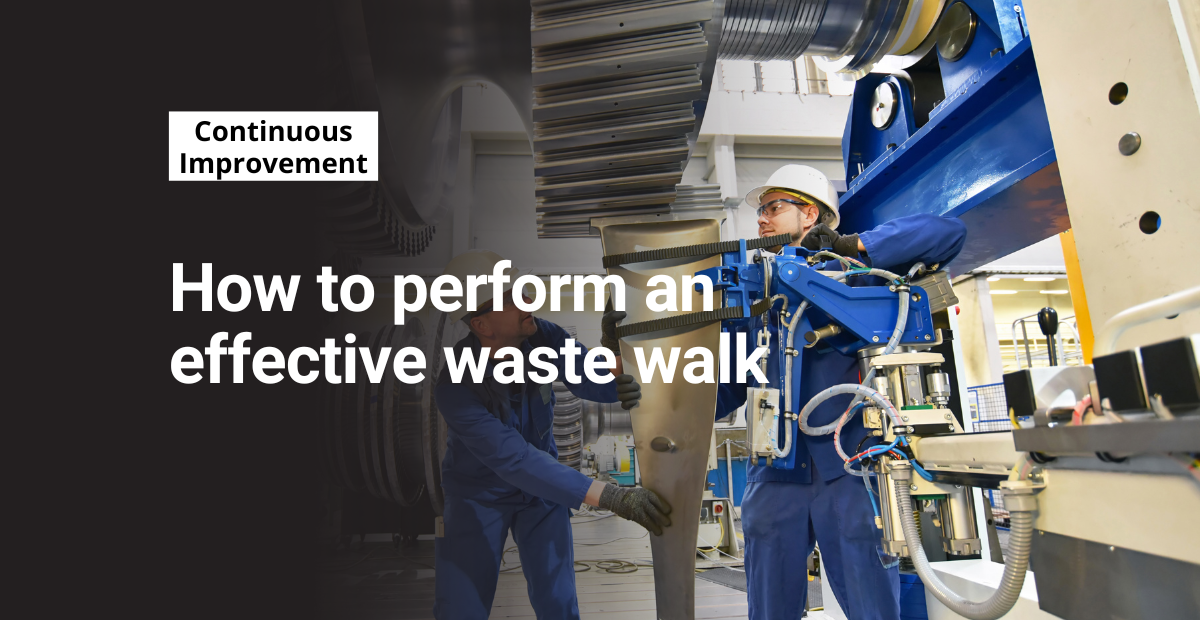A waste walk is a lean management technique that involves physically observing and analyzing work areas, workflows, and practices to identify and eliminate waste. The objective is to uncover non-value-added activities and processes that contribute to inefficiency, delays, defects, and unnecessary costs.
By walking the Gemba, or the actual workplace, individuals gain firsthand knowledge and insights into the existing processes and can identify improvement opportunities. I’ve performed more waste walks than I can count, and these are the steps and best practices I use to get the most out of the process.
Plan and define objectives
Before conducting a waste walk, I always establish a clear plan and define the objectives I want to hit. I also determine the scope of the walk, so I know which specific department or process I’ll review. This helps guide the observations process and will keep you focused on finding the areas that require improvement.
Assemble a diverse team
A best practice is to form a team of individuals from various departments and levels within the organization to conduct the waste walk. Include employees who work directly in the observed process to get the most valuable perspectives and insights.
By having a diverse team, you can gather different viewpoints and ensure a comprehensive analysis.
Educate your team and set ground rules
Before conducting your waste walk, it’s important to teach your team about the different types of waste and the lean principles you’ll use.
As a quick refresher, the seven forms of waste are:
- Transportation
- Inventory
- Motion
- Waiting
- Overproduction
- Overprocessing
- Defects
If your team knows this, they’ll be better equipped to spot inefficiencies.
Another important step before starting is to establish the ground rules of your waste walk. Encourage team members to actively observe and take notes during the walk, capturing relevant information and waste-related observations.
You can even consider providing a checklist or template to facilitate the documentation process. [We have a simple template for free if you’re looking for a place to get started]:
Engage with employees
During the waste walk, engage with employees who perform the processes being observed. Ask open-ended questions to understand their tasks, challenges, and perspectives.
Encourage them to share their ideas for improvement and any suggestions they may have. Engaging with employees fosters a sense of ownership and involvement in the process improvement efforts.
Observe and document
Walk the Gemba and carefully observe the processes, workflows, and activities taking place. Pay attention to potential areas of waste. Examples include:
- Excessive movement
- Waiting times
- Unnecessary inventory
- Rework
Take detailed notes, photographs, and videos that you can use to make further observations even after you’ve finished your waste walk.
Analyze your findings and brainstorm solutions
Once you’ve completed your waste walk, analyze the collected data and observations. Try to identify patterns, root causes, and the impact of each waste type on the overall process.
Then, prioritize areas of improvement based on the severity of waste and the potential benefits of addressing them. This analysis will help you develop an action plan for waste reduction and process optimization.
Once you’ve listed out the areas of improvement, collaborate with people throughout the operation on possible solutions.
You can host brainstorming sessions to explore ideas, encourage creativity, and leverage the collective knowledge and experience of the team. During this time, you should develop an action plan, assign responsibilities, and create an implementation timeline.
Measure progress over time
It’s very important to establish the key HES metrics that you’ll use to track the progress of your waste reduction initiatives.
Once you’ve chosen these metrics, schedule regular reviews of the data to assess the impact of the improvements on process efficiency, productivity, and quality.
This will provide feedback on the effectiveness of the waste walk and help sustain the momentum of continuous improvement efforts.
Foster a culture of continuous improvement
The last best practice I’ll share is to instill a culture of continuous improvement within your organization. You can do this by encouraging employees to proactively identify and address waste in their own work areas.
If you implement a standard way for them to voice their concerns (and for your team to review those issues), you should be able to tackle waste reduction projects all year round.
And, of course, if you perform waste walks on a regular basis, you’ll be able to foster the kind of forward-thinking culture that cuts off waste sources before they produce major costs for your company.
Other posts you might like…
No posts
